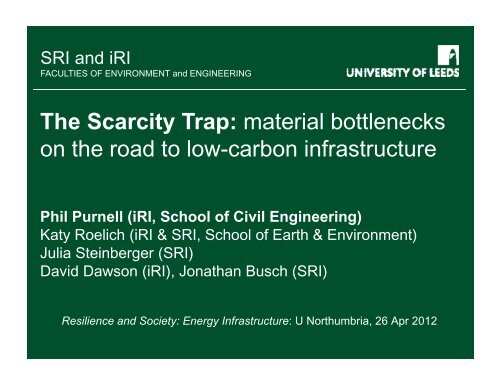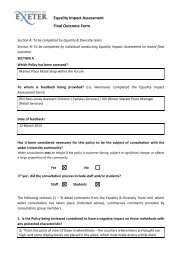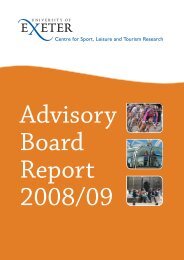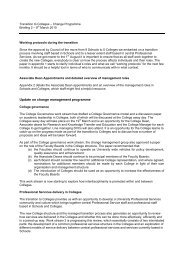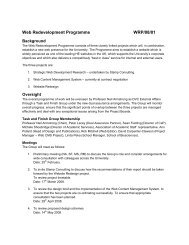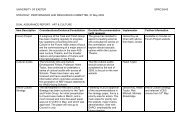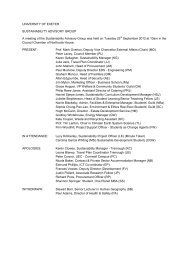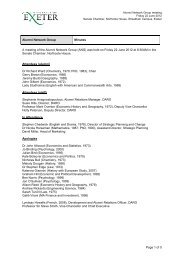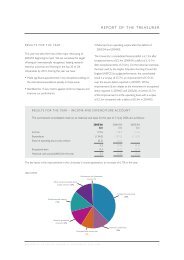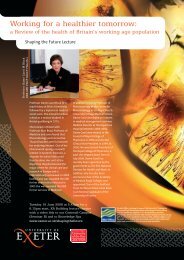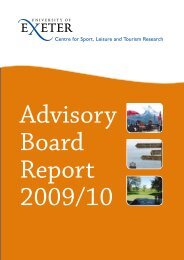The Scarcity Trap: material bottlenecks The Scarcity Trap: material ...
The Scarcity Trap: material bottlenecks The Scarcity Trap: material ...
The Scarcity Trap: material bottlenecks The Scarcity Trap: material ...
Create successful ePaper yourself
Turn your PDF publications into a flip-book with our unique Google optimized e-Paper software.
School SRI and of iRI something<br />
FACULTY FACULTIES FACULTY FACULTIES OF OF OTHER ENVIRONMENT and d ENGINEERING<br />
<strong>The</strong> <strong>Scarcity</strong> <strong>Trap</strong>: <strong>material</strong> <strong>bottlenecks</strong><br />
on the road to low-carbon infrastructure<br />
Phil Purnell (iRI (iRI, School of Civil Engineering)<br />
Katy Roelich (iRI & SRI, School of Earth & Environment)<br />
Julia Steinberger (SRI)<br />
DDavid id D Dawson (iRI) (iRI), JJonathan th BBusch h (SRI)<br />
Resilience and Society: Energy Infrastructure: U Northumbria, 26 Apr 2012
Changing infrastructure<br />
• 500 projects; £250 billion<br />
• environmental impacts –<br />
reducing the carbon intensity<br />
• <strong>The</strong> nature of our national<br />
infrastructure needs to be a<br />
primary driver in the move<br />
towards a low carbon<br />
economy …infrastructure<br />
must also be adaptable… to<br />
meet changing demand<br />
through the adoption of new<br />
technologies and <strong>material</strong>s<br />
2
Changing <strong>material</strong> mix<br />
• Embedding new low CO 2<br />
technology will introduce<br />
critical <strong>material</strong>s into<br />
infrastructure: e.g.<br />
• Nd - motors/generators for wind<br />
turbines & electric vehicles<br />
• Cr –low CO 2 reinforced concrete<br />
• Not just elements: e.g. aggregates,<br />
components, lubricants,<br />
polymers polymers…<br />
http://www.cathodic.co.uk/information/19/14/Elgard_General_Information.htm<br />
3
Changing <strong>material</strong> mix<br />
• Scale of infrastructure means<br />
that change in demand can be<br />
a step-change g<br />
• Multiples, not fractions<br />
• eg e.g. low CO 2 concrete: move to 50%<br />
stainless steel rebar would double EU Cr<br />
imports; move to 10% Ti-based cathodic<br />
protection p could x10 EU Ti imports. p<br />
• Previously abundant <strong>material</strong>s<br />
may y become critical<br />
http://www.cathodic.co.uk/information/19/14/Elgard_General_Information.htm<br />
4
Cr Cr: : India,<br />
Kaz’stan Kaz’stan, , Iran<br />
Cr Cr: : SA,<br />
Zimbabwe<br />
Nd Nd: : China<br />
(97%)<br />
• Vulnerability<br />
Vulnerability: EU/UK are often 100% importers<br />
• Passive/reactive price & supply volatility: Geopolitical<br />
issues<br />
Map source: http://ec.europa.eu/commission_2010-2014/tajani/hot-topics/raw-<strong>material</strong>s/index_en.htm 5
Geopolitics<br />
“<strong>The</strong> US and the EU<br />
asked Beijing to clarify<br />
its policy on mineral<br />
exports after China<br />
stopped shipping to<br />
Japan.<br />
“<strong>The</strong> stoppage followed<br />
a spat between China<br />
and Japan last month<br />
over islands whose<br />
ownership is disputed disputed.<br />
”<br />
6
How do we assure supply?<br />
• Strategic stockpiling<br />
• Trade agreements<br />
• Recycling<br />
• collection vs. “mining<br />
iinfrastructure” f t t ”<br />
• urban mining, urban ores,<br />
urban concentrates…<br />
concentrates “Some Some metal has more<br />
• where, when, in what state<br />
are aetthe estoc stocks? s<br />
on‐surface stock than<br />
underground stock”<br />
K HALADA, National Institute for<br />
Materials Science, Japan<br />
7
Existing models: Stocks & Flows<br />
8
S&F Limitations<br />
• One substance at a time<br />
• Existing infrastructure = aggregate stock of a<br />
given substance; no information on location<br />
• Properties or qquality alit of the ssubstances bstances (e (e.g. g<br />
Cr as element or alloy) are not generally<br />
explicitly accounted for for.<br />
9
<strong>The</strong> Project: A New Model<br />
• the flow of <strong>material</strong>s into & out of infrastructure;<br />
• the stocks of <strong>material</strong>s contained within<br />
infrastructure infrastructure, during operation and demolition;<br />
• the location and properties of these <strong>material</strong>s and<br />
the components they are a part of;<br />
• the criticality of key <strong>material</strong>s, in terms of<br />
ssubstitutability bstit tabilit and ssupply ppl risks risks;<br />
• the interactions between these factors.<br />
10
2<strong>The</strong> 2<strong>The</strong> Project: Methodology<br />
11
2Potential 2Potential<br />
initial case studies<br />
• Low carbon concretes • Move to wind power, p tidal<br />
(Halcrow)<br />
generation etc (Halcrow)<br />
• Move to fibre optic control and<br />
HVDC in power distribution<br />
(National Grid)<br />
• New rail electrification<br />
(Halcrow)<br />
• Move to electric vehicles<br />
(U.Newcastle)<br />
• Energy Storage – bulk vs<br />
decentralised (National Grid)<br />
• Underground U degoudvss overground<br />
o egoud conducters (National Grid)<br />
• Treatment at source vs<br />
centralised treatment, anaerobic<br />
digestion & CHP<br />
(United Utilities/Halcrow)<br />
• Zero-carbon buildings (Arup)<br />
• Active comms on road<br />
infrastructure (Halcrow)<br />
• Decision matrix…<br />
12
2Scoring 2Scoring<br />
criteria<br />
• Data availability – S&F of <strong>material</strong>s and components<br />
• Technical competence – expertise within team<br />
• Scale Scale, likelihood & specificity of intervention<br />
• Collaborators on board<br />
• Politics Politics, novelty and impact in multiple sectors – the<br />
‘wow’ factor<br />
• Cross-over with known criticalities or scarcities<br />
• Complexity vs simplicity – system boundary clearly<br />
defined?<br />
13
2Chosen 2Chosen<br />
case studies<br />
Key factors: data, scenarios, <strong>material</strong>s criticality<br />
Wind turbines + low-CO2 reinforced<br />
concrete<br />
Electric vehicles<br />
14
Model Structure<br />
Infrastructure Technology Materials<br />
Abstract<br />
Structure: Components:<br />
Materials<br />
stock of the<br />
physical physical stock<br />
stocks<br />
required<br />
stock of infra- of infrastructure contained in<br />
service level structure that parts p that<br />
both<br />
directly indirectly<br />
infrastructure<br />
supplies the provide the<br />
and<br />
service service<br />
components<br />
15
Case study: wind power<br />
Infrastructure Technology Materials<br />
Wind Power Structures: Components: Neodymium<br />
Onshore and Permanent<br />
offshore wind magnet<br />
turbines generators g<br />
(PMGs); non-<br />
PMGs<br />
Excluded: Transmission; Other renewables generation<br />
16
Model Structure: dynamic S&F<br />
Infrastructure Technology Materials<br />
Infrastructure<br />
stock<br />
K (i) (t)<br />
I (s) (t) I (c) (t) I (m) (t)<br />
Structure<br />
stock<br />
K (s) (t)<br />
Component<br />
stock<br />
K (c) (t)<br />
Materials<br />
stock<br />
K (m) (t)<br />
O (s) (t) O (c) (t) O (m) (t)<br />
17
Model Structure: lifetimes<br />
Infrastructure Technology Materials<br />
Infrastructure<br />
stock<br />
K (i) (t)<br />
Technolog T gy mix<br />
I (s) (t) I (c) (t) I (m) (t)<br />
Structure<br />
stock<br />
K (s) (t)<br />
Compone C nt mix<br />
Component<br />
stock<br />
K (c) (t)<br />
Material M inntensity<br />
Materials<br />
stock<br />
K (m) (t)<br />
O (s) (t) O (c) (t) O (m) (t)<br />
St Structure t lifetime lif ti CComponent t lif lifetime ti MMaterial t i l lif lifetime ti<br />
L (s) (t, t 0)<br />
L (c) (t, t 0)<br />
L (m) (t, t 0)<br />
18
Scenario input: wind power<br />
Scenarios also contain<br />
technology mix (from<br />
which <strong>material</strong>s mix is<br />
derived)<br />
~ current UK electricity capacity<br />
Future UK wind generation<br />
(DECC, 2010)<br />
19
Results – Nd demand<br />
Annual UK Neodymium demand from wind<br />
power technology<br />
20
Results – Nd demand (
Future Additions: Criticality?<br />
Share of o world Ndd<br />
productioon<br />
5%<br />
4%<br />
3%<br />
2%<br />
1%<br />
UK Low Carbon Technology Share of World Production<br />
0%<br />
2010 2015 2020 2025 2030 2035 2040 2045 2050<br />
Wi Wind d % prod d<br />
Car % prod<br />
Combined %<br />
22
Scenario input – electric vehicles<br />
~ current UK vehicles registered<br />
Future UK electric vehicles (total)<br />
23
Results – Li demand<br />
24
Results – Pt potential recyclate<br />
Lowest annual peak is<br />
equivalent to<br />
£6 billion (present<br />
market k t price) i )<br />
25
2Summary 2Summary<br />
• Potential for low-CO low CO 2 infrastructure roll-out roll out to be disrupted<br />
by <strong>material</strong>s criticality: thus assessments of vulnerability<br />
need to be inniiated to inform policy decisions<br />
• Enhanced stocks & flows models can highlight likely<br />
criticalities: advanced models will enumerate vulnerability<br />
• AAs well ll as ‘ ‘scare stories’, t i ’ potential t ti l ffor significant i ifi t resource<br />
recovery from the infrastructure can also be identified<br />
• Work in progress progress…<br />
26


